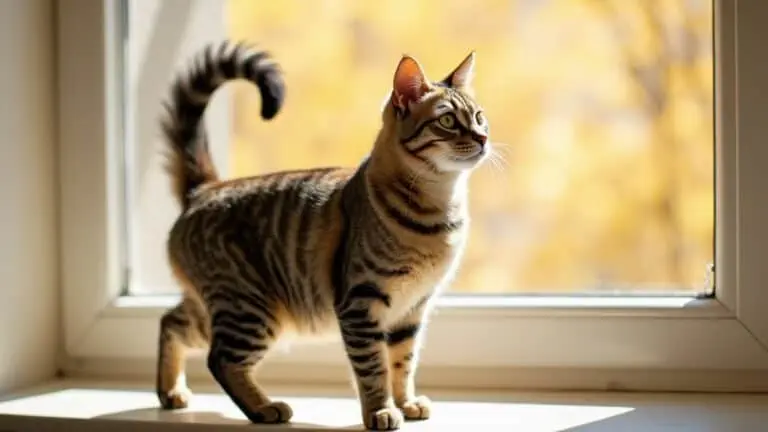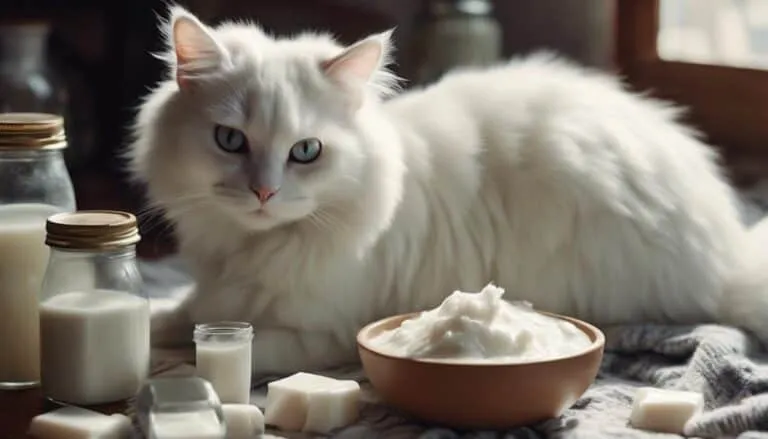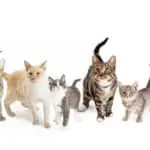The Best Fluffy Pancakes recipe you will fall in love with. Full of tips and tricks to help you make the best pancakes.

Plastic bags have long been a subject of fascination for our feline companions, captivating their attention and drawing them in with an inexplicable allure. Despite the apparent mundanity of these everyday objects, cats find themselves irresistibly drawn to them.
In this article, we will delve into the reasons behind this peculiar attraction and shed light on the potential dangers it poses to our beloved pets. By understanding the underlying factors that drive cats towards plastic bags, we can effectively address their safety and well-being, ensuring a harmonious coexistence between our feline friends and these seemingly innocuous items.
Key Takeaways
- Cats are attracted to plastic bags due to the crinkly noise, distinct movement, and different sensory experience they provide.
- The smell and taste of beef tallow in plastic bags can also attract cats.
- While cats find plastic bags fascinating, there are potential dangers such as suffocation, ingestion hazards, and chemical exposure.
- To prevent cats from interacting with plastic bags, store them out of reach, provide alternative hiding spots, use deterrents, supervise their behavior, and dispose of bags properly.
Reasons for Cats' Fascination
Cats' fascination with plastic bags can be attributed to a combination of sensory stimulation, instinctual behaviors, and the unique characteristics of plastic bags themselves.
From a psychological perspective, cats are attracted to the crinkly sound and texture of plastic bags, which stimulates their sensory receptors and triggers their curiosity.
The impact of this fascination on their behavior is evident in their playfulness, as they enjoy batting and pouncing on moving plastic bags.
Additionally, plastic bags provide a cozy and warm spot for cats to relax, promoting feelings of security and comfort.
However, it is essential to recognize the potential dangers associated with cats interacting with plastic bags, such as suffocation risk and ingestion hazard.
Therefore, it is important for cat owners to take precautions and provide alternative options to prevent cats from accessing and engaging with plastic bags.
Sensory Appeal of Plastic Bags
The sensory appeal of plastic bags is rooted in their unique characteristics and the stimuli they provide to a cat's senses. Cats are naturally attracted to the crinkly noise that plastic bags make, which can mimic the sound of crunchy leaves in the wild.
The distinct way that plastic bags move also intrigues cats, as it offers a different sensory experience compared to other objects. Additionally, the texture and feel of plastic bags provide a comforting and snug environment for cats, similar to the feeling of being wrapped up.
The faint scent and taste of beef tallow, which is sometimes present in plastic bags, can further attract cats due to their strong sense of smell. However, it is important to consider the potential impact on the environment and the need for training alternatives to prevent cats from interacting with plastic bags.
Psychological Factors at Play
The fascination cats display towards plastic bags can be attributed to various psychological factors that contribute to their attraction and engagement with these objects.
Understanding feline behavior is key to unraveling this phenomenon. Cats are known to be curious creatures, and the impact of environmental factors on their behavior cannot be underestimated.
The crinkly noise and distinct movement of plastic bags provide sensory stimulation that captures a cat's attention. The interactive nature of plastic bags, their ability to mold to a cat's shape, and the potential smell of beef tallow further enhance their appeal.
Cats may also find comfort, warmth, and security in the snug environment that a plastic bag offers. Additionally, the unique sounds produced by plastic bags may trigger a cat's hunting instincts.
Potential Hazards and Risks
Potential dangers arise when cats come into contact with plastic bags. These dangers include the risks of suffocation, ingestion, chemical exposure, entanglement, and the potential for stress and anxiety.
To prevent accidental ingestion, it is important to store plastic bags out of reach and dispose of them properly. Cats may chew on plastic bags, leading to gastrointestinal blockage, which can be life-threatening.
Chemical exposure is another concern, as plastic bags may contain harmful substances that can harm cats when ingested or absorbed through their skin.
Cats' claws or tails can also become entangled in the handles or openings of bags, causing injury.
Additionally, the presence of plastic bags can cause stress and anxiety in cats. Therefore, it is crucial to provide alternative hiding spots and redirect their attention to toys or scratching posts to minimize their stress and anxiety levels.
Preventive Measures for Cat Owners
To ensure the safety and well-being of cats, it is essential for cat owners to implement preventive measures that minimize their feline companions' interaction with plastic bags.
Cat proofing homes is crucial in creating a safe environment for cats. This can be achieved by storing plastic bags out of reach, either in closed cabinets or secure containers.
Providing alternative play options is also important to divert cats' attention away from plastic bags. Offering cozy cat beds or hiding boxes as alternatives can give cats a comfortable and safe spot to relax.
Additionally, using cat-safe deterrents, such as citrus scents, can discourage cats from approaching plastic bags. Supervising cats and redirecting their attention to toys or scratching posts when they show interest in plastic bags is another effective preventive measure.
Promoting Environmental Enrichment
Environmental enrichment plays a crucial role in maintaining the overall well-being and mental stimulation of cats. To promote environmental enrichment for cats, consider the following:
- Benefits of interactive toys:
- Interactive toys provide mental stimulation and physical exercise, helping cats release energy and maintain a healthy weight.
- Toys that mimic hunting behavior, such as puzzle feeders or treat-dispensing toys, can engage cats' natural instincts and provide hours of entertainment.
- DIY enrichment ideas:
- Engaging in do-it-yourself enrichment activities can be both cost-effective and fun.
- Creating homemade puzzle feeders or hiding treats around the house can encourage cats to use their problem-solving skills and keep them mentally stimulated.
- Creating vertical spaces:
- Cats love to climb and explore their environment.
- Providing vertical spaces, such as cat trees or wall shelves, allows cats to exercise their natural climbing instincts and gives them a sense of security and territory.
- Rotating toys and playtime:
- Cats can quickly lose interest in the same toys.
- To keep them engaged, rotate their toys regularly and schedule daily playtime sessions.
- This not only stimulates their minds but also strengthens the bond between cats and their owners.
Importance of Seeking Veterinary Advice
Seeking veterinary advice is essential when dealing with unusual cat behaviors or potential risks associated with their interaction with plastic bags. Early intervention is crucial in recognizing behavioral changes and addressing them promptly to ensure the well-being of the cat.
Veterinary professionals possess the knowledge and experience to assess the situation accurately and provide appropriate guidance. They can evaluate the cat's behavior, rule out any underlying medical conditions, and recommend safety measures tailored to the specific needs of the cat.
Ensuring Cat's Well-being and Safety
When addressing the well-being and safety of cats, it is crucial to implement measures that prioritize their physical and mental health while minimizing potential risks associated with their fascination with plastic bags.
To ensure the well-being and safety of cats, the following steps can be taken:
- Cat-proofing homes: Remove plastic bags from the cat's environment or store them securely in closed cabinets or containers to prevent access.
- Provide alternative play options: Offer a variety of interactive toys, scratching posts, and puzzles to engage the cat's natural instincts and provide mental stimulation.
- Supervise and redirect: Keep a close eye on the cat's behavior around plastic bags and redirect their attention to appropriate toys or play activities.
- Create a stimulating environment: Enhance the cat's living space with hiding spots, climbing structures, and environmental enrichment tools to promote physical exercise and mental engagement.
Frequently Asked Questions
Are All Cats Attracted to Plastic Bags, or Is It Just a Select Few?
The attraction of cats to plastic bags varies among individuals. While some cats may be drawn to the crinkly sound and interactive nature of plastic bags, not all cats exhibit this behavior. Factors such as previous experiences and individual preferences can influence a cat's attraction to plastic bags.
Can Cats Become Obsessed With Plastic Bags to the Point Where It Interferes With Their Daily Activities?
Yes, cats can become obsessed with plastic bags to the point where it interferes with their daily activities. This can pose health risks, such as suffocation and ingestion hazards, and may have long-term effects on their well-being. Seeking veterinary advice is recommended.
How Can I Prevent My Cat From Chewing on Plastic Bags?
To prevent cats from chewing on plastic bags, provide alternative toys and objects that are safe for them to chew on. Engage in interactive play with your cat using toys specifically designed for chewing.
Are There Any Signs That Indicate My Cat May Be Stressed or Anxious Around Plastic Bags?
Signs of stress or anxiety in cats around plastic bags include hiding, excessive grooming, increased aggression, and avoidance behavior. To help your cat overcome anxiety, provide alternative hiding spots, use deterrents, supervise their interaction, and seek veterinary advice if needed.
Is It Safe for Cats to Play With Plastic Bags Under Supervision?
While it may be tempting to let cats play with plastic bags under supervision, it is not safe. Cats can get tangled, ingest plastic, or suffocate. Instead, provide safe and stimulating environmental enrichment activities for their well-being.
Conclusion
In conclusion, the strange attraction of cats to plastic bags can be attributed to a combination of factors, including the malleability, auditory appeal, and unique movement of these objects.
However, it is crucial for cat owners to be aware of the potential hazards and risks associated with their pets' interaction with plastic bags.
By implementing preventive measures, such as providing alternative sources of enrichment and seeking veterinary advice, we can ensure the well-being and safety of our feline companions.








